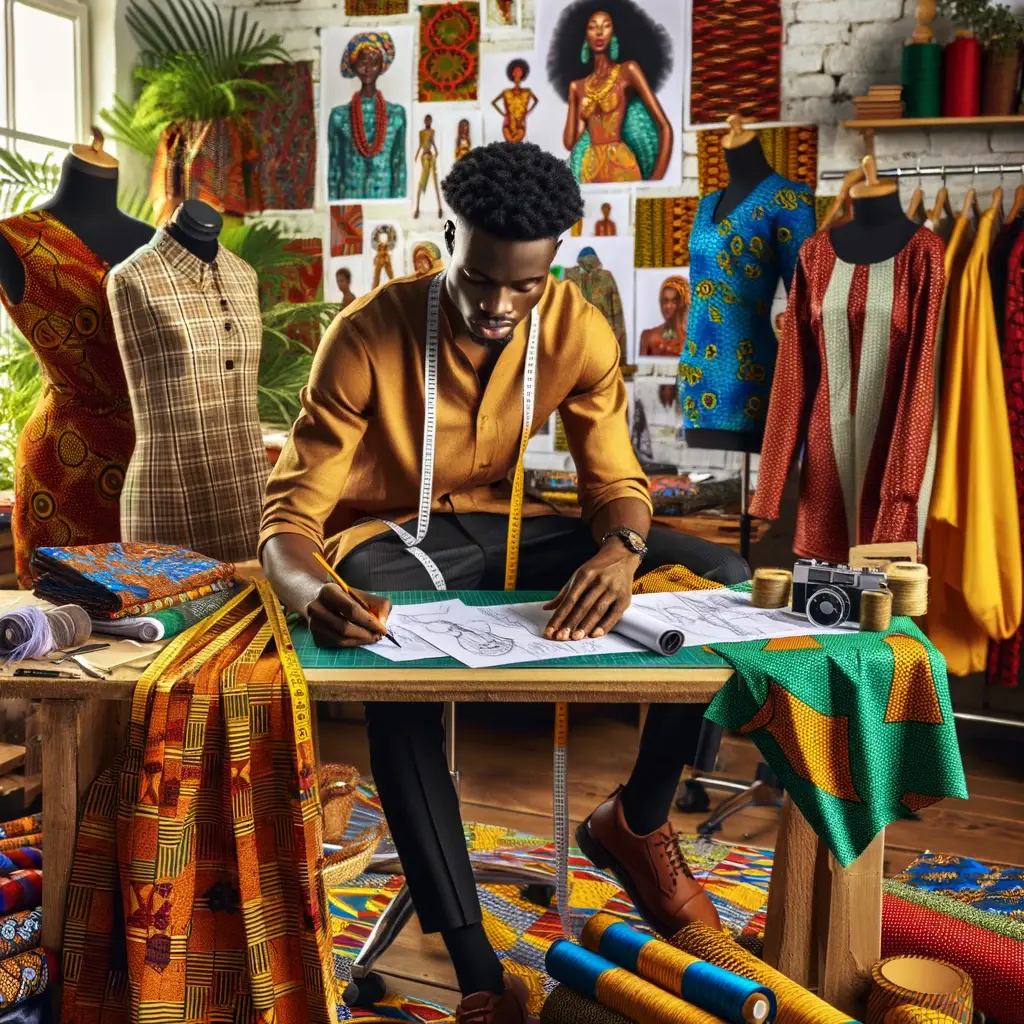Introduction
Design and sustainability are two interconnected concepts that play a crucial role in shaping our world.
Design refers to the process of creating solutions to meet human needs and desires, while sustainability involves the responsible use of resources to ensure the long-term viability of our planet.
In the Nigerian context, the intersection of design and sustainability is of utmost importance.
Nigeria, being Africa’s most populous country, faces numerous challenges such as rapid urbanization, pollution, and climate change.
These issues necessitate innovative and sustainable design solutions to create a better future for its citizens.
Design and sustainability in Nigeria go beyond just environmental concerns; they also encompass social and economic aspects.
Designing sustainable infrastructure, buildings, and transportation systems can improve the quality of life for Nigerians while minimizing negative impacts on the environment.
Furthermore, incorporating sustainability into design practices can foster economic growth by creating opportunities for green industries and promoting energy-efficient technologies.
This is especially significant for Nigeria, as the country strives to diversify its economy and reduce its dependence on oil.
By embracing sustainable design principles, Nigeria has the potential to become a leader in the region, driving positive change and inspiring other African nations to follow suit.
It is crucial for designers, policymakers, and businesses in Nigeria to actively collaborate and integrate sustainability into their practices to achieve a more resilient and prosperous future.
In the following sections, we will explore various aspects of design and sustainability in the Nigerian context, highlighting innovative projects, challenges, and opportunities for sustainable development.
Together, we can create a more sustainable Nigeria and contribute to the global efforts for a greener and more equitable world.
Sustainability challenges in Nigeria
Nigeria grapples with pressing sustainability challenges—environmental degradation, pollution, poverty, and inequality—hampering its progress.
- Deforestation: High deforestation rates, driven by logging and agriculture, harm ecosystems and worsen climate change.
- Pollution: Urban areas suffer from severe air, water, and soil pollution, posing health hazards due to inadequate waste management and industrial activities.
- Social Issues: Poverty affects a significant portion, limiting access to basic amenities like clean water and electricity.
- Inequality: A vast wealth gap exists, with a small elite controlling most resources.
Sustainability adoption is vital:
- Climate Mitigation: Promoting renewable energy reduces fossil fuel dependency and combats climate change.
- Economic Growth: Investment in renewable energy and sustainable agriculture generates jobs and boosts economic growth.
- Global Reputation: Nigeria can lead in sustainable development, attracting foreign investments and global collaborations.
To achieve this, Nigeria must:
- Government Action: Develop policies for environmental conservation, sustainable resource management, and strict pollution regulations.
- Infrastructure Investment: Build renewable energy infrastructure and promote sustainable agriculture.
- Education and Awareness: Collaborate across sectors to educate the population on sustainability’s significance and provide training on sustainable practices.
In summary, Nigeria confronts pressing sustainability challenges that span environmental and social realms.
Embracing sustainable practices can pave the way for a healthier, more prosperous future by addressing deforestation, pollution, poverty, and inequality.
Read: Career Paths: Where Can Design Take You in Nigeria Today?
Design Principles for Sustainability
Designing sustainably is crucial globally and in Nigeria, with key principles to follow for a greener future:
- Material Selection: Choose sustainable materials like renewables, recycled, and low-impact options.
- Energy Efficiency: Design for minimal energy consumption through efficient insulation and lighting.
- Waste Reduction: Emphasize recycling, reusing, and composting for a circular approach.
- Water Conservation: Incorporate rainwater harvesting and efficient plumbing fixtures.
- Biomimicry: Draw inspiration from nature for efficient and eco-friendly designs.
- Life-cycle Assessment: Consider the full product or building life cycle.
- Social Impact: Engage communities and ensure accessibility in designs.
Globally, sustainability thrives:
- Green Building Certification: LEED encourages energy efficiency, water conservation, and indoor air quality.
- Circular Economy: Patagonia promotes product longevity and recycling.
- Urban Farming: Rooftop gardens reduce transportation emissions.
- Renewable Energy: Iceland harnesses geothermal power.
- Sustainable Transportation: Copenhagen leads in cycling infrastructure.
- Zero-waste Initiatives: Berlin’s Original Unverpackt minimizes waste.
- Biomimetic Innovations: Zimbabwe’s Eastgate Centre uses termite-inspired cooling.
Nigeria’s sustainable design potential:
- Education and Awareness: Educate designers on sustainability’s importance.
- Government Support: Create policies incentivizing sustainable design.
- Local Materials: Use indigenous resources and techniques.
- Cross-sector Collaboration: Engage designers, government, NGOs, and communities for holistic solutions.
Nigeria can lead in sustainable design, fostering a resilient and eco-friendly future.
Read: How to Network in the Design Industry in Nigeria: A Guide
Current state of design in Nigeria
Design in Nigeria has grown across fashion, architecture, and product design, reflecting cultural richness and creativity.
Notable designers like Lisa Folawiyo and Demas Nwoko have gained global recognition. However, sustainability integration remains a challenge.
- Vibrant Design Industry: Nigeria’s design scene showcases rich cultural heritage and creativity, gaining international recognition.
- Fashion Growth: Designers like Lisa Folawiyo and Deola Sagoe have excelled globally.
- Architectural Innovation: Renowned architects like Demas Nwoko have reshaped Nigeria’s urban landscape.
- Sustainability Gaps: Despite progress, sustainability considerations lag in design, impacting the environment and society.
Extent to which sustainability is integrated into design practices
- Education: Formal training in sustainable design principles must be integrated into design school curricula.
- Materials and Processes: Designers should adopt eco-friendly materials, recycling, upcycling, and energy-efficient processes.
- Collaboration: Stakeholder cooperation fosters sharing knowledge, resources, and eco-friendly practices.
- Consumer Awareness: Educating consumers about sustainable design’s significance empowers informed choices.
- Government Support: Policies and incentives can encourage eco-friendly design practices, benefitting both designers and the environment.
Basically, Nigeria’s diverse design industry has made strides but needs stronger sustainability integration.
By addressing education, materials, collaboration, consumer awareness, and government support, Nigeria can foster a more sustainable design sector, respecting culture and the environment.
Read: The Importance of Ethics in Nigeria’s Design Profession
Case studies of sustainable design initiatives in Nigeria
Design and sustainability converge in Nigeria as organizations and individuals tackle environmental challenges with innovative sustainable initiatives.
- Lekki Conservation Centre: An exemplar of sustainable architecture promoting biodiversity and environmental education in Lagos.
- Nuli Juice: Prioritizes sustainability by sourcing locally, reducing waste, and eco-friendly packaging, benefiting communities and the environment.
- Green Building Council of Nigeria (GBCN): Certifies green buildings, encouraging eco-friendly practices in construction, enhancing energy efficiency and waste management.
- Nigerian Renewable Energy Action on Ecosystems Restoration (NREAN): Integrates renewable energy with sustainable design and reforestation in rural communities.
- Art and Energy Collective: Engages art to raise awareness about renewable energy’s benefits through exhibitions and workshops.
These cases demonstrate how sustainable design positively impacts Nigeria’s environment and society, paving the way for a greener future.
Essentially, Nigeria is embracing the fusion of design and sustainability, evident in initiatives like the Lekki Conservation Centre, Nuli Juice, GBCN, NREAN, and the Art and Energy Collective.
These models inspire wider adoption of eco-friendly design practices for a sustainable and prosperous Nigeria.
Read: Traditional vs. Modern: Design Aesthetics in Nigerian Culture

Opportunities and Challenges for Design and Sustainability in Nigeria
Design and sustainability in Nigeria present both opportunities and challenges.
Integrating sustainability into design practices can have potential benefits, but there are also obstacles and limitations that may hinder progress.
In Nigeria, there is a growing recognition of the need to incorporate sustainability into design practices.
This presents numerous opportunities for both designers and the environment.
- Increased Awareness: Integrating sustainability into design can raise awareness about environmental issues and promote eco-conscious living.
- Economic Growth: Sustainable design practices can lead to economic growth by creating new industries and job opportunities.
- Resource Management: Design can help optimize resource management by exploring renewable energy sources and reducing waste.
- Cultural Preservation: Incorporating sustainable design practices can help preserve and showcase Nigeria’s rich cultural heritage.
- Infrastructure Development: Designing sustainable infrastructure can improve the quality of life for Nigerians by providing access to clean water, energy, and transportation.
Despite the opportunities, there are several challenges that need to be addressed to fully integrate sustainability into design practices in Nigeria.
- Limited Awareness: Many designers and the general public may lack awareness and understanding of sustainable design principles.
- Lack of Resources: Limited access to resources, funding, and technology can hinder the implementation of sustainable design practices.
- Political Commitment: A lack of political will and commitment to sustainability can slow down progress in implementing sustainable design practices.
- Regulatory Framework: Inadequate or nonexistent regulations and policies can impede the adoption of sustainable design practices.
- Cultural Mindset: Traditional mindsets and cultural practices may not always align with sustainable design principles, requiring a shift in attitudes and behavior.
Potential Benefits of Integrating Sustainability into Design Practices
The benefits of integrating sustainability into design practices in Nigeria are significant and far-reaching.
- Environmental Preservation: Sustainable design practices minimize environmental impact, reduce pollution, and protect natural resources.
- Health and Well-being: Designing sustainable spaces promotes better health outcomes by improving air and water quality, and enhancing overall well-being.
- Resilience and Adaptation: Sustainability in design prepares communities to better cope with climate change impacts and natural disasters.
- Energy Efficiency: Sustainable design practices prioritize energy efficiency, reducing reliance on fossil fuels and lowering energy costs.
- Enhanced Reputation: Organizations and individuals known for their sustainable design practices gain a positive reputation and attract socially conscious clients and investors.
Potential Obstacles and Limitations
While the benefits are evident, there are obstacles and limitations that pose challenges to fully integrating sustainability into design practices.
- Cost Implications: Sustainable design practices can be initially more expensive, requiring investments in research, materials, and training.
- Lack of Expertise: There may be a shortage of skilled professionals with expertise in sustainable design practices.
- Resistance to Change: Some stakeholders may resist implementing sustainable design practices due to perceived inconvenience or resistance to new ideas.
- Complexity: Integrating sustainability into design requires holistic thinking and interdisciplinary collaboration, which can be logistically challenging.
- Educational Gaps: The education system needs to integrate sustainability into curricula to prepare the next generation of designers.
In essence, the intersection of design and sustainability in Nigeria offers immense opportunities for creating a more environmentally and socially conscious society.
However, addressing the challenges and limitations is essential to fully realize the potential benefits and progress towards a sustainable future.
Government and Policy Support for Sustainable Design in Nigeria
Government policies play a pivotal role in shaping sustainable design practices in Nigeria. Let’s evaluate their impact:
- Legislative Framework: Nigeria has a robust legislative framework for sustainability, with laws like the National Environmental Standards and Regulations Enforcement Agency Act.
- National Industrial Policy: The National Industrial Revolution Plan (NIRP) aims to promote eco-friendly manufacturing processes and sustainable product design.
- Tax Incentives: Government offers tax incentives to companies engaging in sustainable design, encouraging eco-conscious practices.
- Environmental Impact Assessments: Stringent environmental impact assessments are required for projects, ensuring they adhere to sustainability principles.
- Energy Efficiency Standards: The government mandates adherence to energy efficiency standards in building designs, reducing energy consumption.
Despite these policies, challenges remain:
- Enforcement: Stricter enforcement is needed to ensure compliance with sustainability regulations.
- Access to Funding: Many designers lack access to funding for sustainable projects.
- Capacity Building: Ongoing training and capacity building are essential for designers to stay updated on sustainable practices.
In a nutshell, government policies, agencies like the Federal Ministry of Environment and NESREA, NGOs, building codes, incentives, and grants collectively advance sustainable design in Nigeria.
However, addressing awareness and resource limitations is essential for widespread adoption.
You Might Also Like: Challenges in Production Design Profession in Nigeria
Importance of education and awareness
Education and awareness are pivotal for promoting sustainable design in Nigeria. Reasons for their significance include:
- Environmental Preservation: Education encourages eco-friendly choices in daily life and design work.
- Reducing Carbon Footprint: Awareness enables designers to create energy-efficient, low-emission products, buildings, and infrastructure.
- Resource Conservation: Education emphasizes responsible resource use in design, conserving water, energy, and materials.
- Health Improvement: Sustainable design enhances well-being by reducing indoor air pollution and creating healthier living spaces.
- Fostering Creativity: Education challenges designers to innovate eco-friendly solutions, driving unique design concepts and techniques.
- Economic Growth: Awareness contributes to sustainable business growth, job creation, and economic stability in Nigeria.
- Cultural Heritage Preservation: Sustainable practices blend with traditional designs, preserving Nigeria’s cultural heritage.
- Climate Change Mitigation: Education empowers designers to reduce emissions and adapt to climate challenges.
- Promoting Collaboration: Initiatives bring professionals and communities together, fostering knowledge exchange and collective problem-solving.
- Sustainable Future: Education and awareness instill a culture of sustainability, benefitting present and future generations in Nigeria.
Discover More: Graphic Design Tools and Software Popular in Nigeria’s Market
Conclusion
This blog post has highlighted the key points regarding the intersection of design and sustainability in Nigeria.
We discussed the importance of incorporating sustainable practices in design, such as using renewable materials and energy-efficient solutions.
We also explored the potential impact of sustainable design on addressing environmental challenges and promoting social and economic development in Nigeria.
The integration of sustainable practices in design can contribute to the conservation of resources, reduction of waste generation, and improvement of quality of life for Nigerians.
It is evident that the intersection of design and sustainability is crucial in shaping a more sustainable future for Nigeria and should be a priority for designers, policymakers, and stakeholders in the country.
By embracing sustainable design principles, Nigeria can achieve a balance between economic growth and environmental preservation, creating a sustainable and thriving society for present and future generations.




